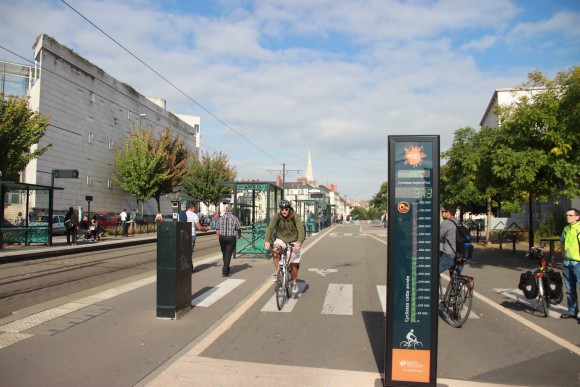Check our datamap here: www.ecf.com/cycling-data
Cities have recently started to consider how data collection can be used for bicycle policies.
We are indeed facing a new era of open and massively available data!

 Transport-wise, data is already used daily for public transport,to keep car traffic flowing, to make public transport better and improve user experiences. Concerning cycling, many cities usually only know roughly how many people are cycling every day. Until recently, the main methods of collecting this information are human or mechanical counts and labor-intensive surveys, automatic bicycle counters to estimate the total amount of users on a portion of a route (eg. pneumatic tubes laid across the roadway, piezo-electric sensors embedded in the roadway, inductive loops cut into the roadway, devices using some sort of transmitting energy such as radar waves or infrared beams to detect vehicles passing over the roadway), Just like the monitoring system for car traffic, there are also camera systems that count cyclists, some even with automatic user recognition.
Transport-wise, data is already used daily for public transport,to keep car traffic flowing, to make public transport better and improve user experiences. Concerning cycling, many cities usually only know roughly how many people are cycling every day. Until recently, the main methods of collecting this information are human or mechanical counts and labor-intensive surveys, automatic bicycle counters to estimate the total amount of users on a portion of a route (eg. pneumatic tubes laid across the roadway, piezo-electric sensors embedded in the roadway, inductive loops cut into the roadway, devices using some sort of transmitting energy such as radar waves or infrared beams to detect vehicles passing over the roadway), Just like the monitoring system for car traffic, there are also camera systems that count cyclists, some even with automatic user recognition.
Featured picture by Ed Yourdon
Using new technologies to track cycling activity
However, the newest technology to capture big amounts of cycling data is to use a GPS tracking activity device (eg. smartphone). Checking our surroundings, it seems like every city has or is developing an application for bicycle use. To name a few: See.Sense (UK, Ireland and others), Bike your City (Athens/Greece), Ring Ride (Vienna/Austria), Cykelstaden (Gothenburg), Bike citizen, GéoVélo (French cities), Strava Metro, Bikes vs. Cars (Malmö/Skåne and Cykelfrämjandet), BikePrint (Netherlands), etc.
Cities that don’t have a big budget to develop an own app, can join the European Cycling Challenge, a competition to motivate citizens to cycle more combined with an app to collect cycling data and the necessary Heatmaps to analyse the collected data. Initiated in Bologna in 2012 and now over 30 EU-cities joined the annual Challenge.
Acknowledge – Measure – Know & Implement
The growing number of cycling apps is a positive sign of more attention for urban cycling. Both for advocacy and city workers, data collection on cycling is important to know if the situation for urban cycling is getting better or worse. As the saying goes: “you can’t manage what you don’t measure“.
The data provided by these apps is useful for cities, advocacy groups and users.
First and foremost, cities that measure cyclists are taking them serious. The collected data often serves as proof to implement new cycling policies and infrastructure. They make municipalities aware of existing practices in their cities; preferred routes (commute or school runs during the week/ recreational rides during the weekend), number and type of cyclists (on sunny/rainy days), average and top speed (rush hour or not), waiting times and delays at crossroads or strategical nodes, cyclists, top destinations (useful for parking policies), specific problems on the bike path (eg. Brussels fix my street app ensures direct communication with cyclists). etc.
Moreover, it gives cities great feedback on cycling policies. For example, if new infrastructure is built, let’s say a bicycle bridge, thanks to various methods of data collection the city will know if the new infrastructure is used, how and when, to what purpose and therefore it will enable the transport department to calculate the effective impact of its policies. A precisely calculated increase in bike practice can actually be measured on the whole area of interest.
 Bike heatmap of Vienna from BikeCitizens
Bike heatmap of Vienna from BikeCitizens
Cycling data are also of great use to bicycle advocacy groups. It can usually stand as proof that (better) infrastructure is needed and that there is an actual demand in specific areas of a city/country/region. For example Ring Ride, Velodossier or My Bike World (the last 2 are no apps but websites with advocacy purposes, but they collect data anyway).
As for the users analyzing real time data provides them with safer routes in good condition, inform them on weather conditions, traffic, construction etc. Bike sharing systems already make full use of these possibility (“how many bikes are available at the nearest station?”). Realtime data is an essential tool to help users to integrate the bicycle in a multi-modal journey and intelligent transport service system. In addition to this, most apps add useful information on the impact of bike use on health, personal savings and reduced emissions.
Today, the process of data collection and the aggregation and analysis of the data still cost a lot of money. Many cities and regions have invested big budgets to collect this data from car traffic but are hesitant to invest much smaller budgets to do the same for cycling. Although it is quite clear that the bicycle has a role to play in our smart cities. In the long run however, it might be cheaper to enable the majority of bike users to track their activity rather than to organize massive manual count campaigns. This would reduce the inequality between big metropolitan areas or cities that have bigger budgets devoted to transportation policies and the smaller/mid-sized cities who can be reluctant to implementing cycling measures.
What does the EU do?
Should individual cities and businesses continue to take care of handling the data or should the EU step in to get more access to much needed data on cycling?
Cycling has been included in 3 flash Eurobarometer surveys but these surveys are not done at a regular rythm and the questions are not always asked in the same way, which makes it difficult to compare data from several years or to see progress/regress.
The Eltis Modal Split tool which shows modal split data from 299 European cities over 100.000 inhabitants, 131 EU cities under 100.000 and 12 Non-European cities would be very useful if the data was more up to date (some information dates from 2008) and if the measuring would be more harmonised (sometimes no information is given about the method of data collection).
The EU Commission is working on an Urban Mobility Scoreboard with a harmonized set of indicators for car use, public transport, walking and cycling to which ECF has contributed feedback.
One very useful EU-rule: Data collected by local governments should be made available to consult on simple demand.
